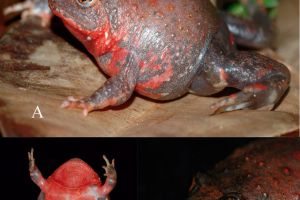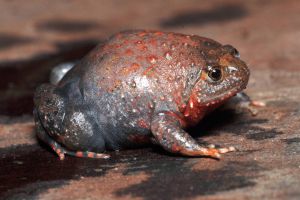
Frogs of Borneo

Frogs of Borneo

Frogs of Borneo

Frogs of Borneo

Frogs of Borneo

Frogs of Borneo

Frogs of Borneo

Frogs of Borneo

Frogs of Borneo

Frogs of Borneo

Frogs of Borneo
Bornean Families
Glyphoglossus:
capsus
Red Burrowing Frog
Glyphoglossus capsus is a brightly colored species of microhylid frog. It was first described by our team in 2014 from Borneo, specifically from Gunung Penrissen, Sarawak (936 m a.s.l.), and from Gunung Serapi, Matang Range, Sarawak. This species has also been referred to as the “Red Hot Chili Pepper” frog due to its distinctive coloration: the dorsum is olive to brown with numerous bright red spots, especially around wart-like structures. The underside (venter) features a striking combination of bright red along with areas of white and dark marbling.
This is a medium-sized species of Glyphoglossus; the two known adult male specimens measured 34.2 mm and 36.0 mm in snout–vent length (SVL). It shares several characteristics typical of the genus: the body is rounded and somewhat flattened; the head is broad with a short snout; and the eyes are relatively small. The tympanum, or external eardrum, is covered by skin. Both maxillary and vomerine teeth are present. On the feet, there is a shovel-shaped inner metatarsal tubercle, and the finger and toe tips are not expanded. The webbing between the toes is reduced. Additionally, there are no spiny projections on the elbows or heels, and the hands lack enlarged tubercles. However, this species can be distinguished from other currently recognized Glyphoglossus by a unique combination of traits. The skin on the back is granular in texture, and there is a faint dermal fold across the forehead. The supratympanic fold (the ridge above the eardrum) is poorly defined. The toe tips are blunt, the webbing is limited to the base of the toes, and lateral fringes are present on the first four toes. An outer metatarsal tubercle is also visible. The pupils are round.
In terms of coloration, the upper body (dorsum) is greyish or olive-brown with red spots, while the underside (venter) features a large red area covering the throat, chest, and part of the belly. The posterior part of the belly has white patches.
Like other members of this genus, G. capsus is likely fossorial (burrowing), spending much of its time underground and probably surfacing mainly during the rainy season for breeding. The species appears to tolerate fragmented, anthropogenically altered forests to some degree. Details of its reproductive activities remain unknown; the tadpole is also unknown.
Version tracking
-
31.07.2025
updated


